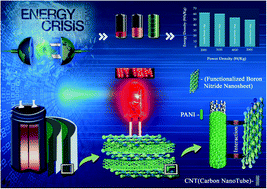Facile functionalization of boron nitride (BN) for the development of high-performance asymmetric supercapacitors†
Abstract
The ongoing demand for supercapacitors with high energy density, stability, and a wide range of working potential for device applications is a great challenge to researchers. In this study, we have explored suitability of nanocomposites based on functionalized BNs (mK-BN/mH-BN), CNTs, and polyaniline (PANI) as supercapacitor electrodes to address this demanding issue. We have also focused on the enhancement of the electrochemical activity of BN with surface functionalization. FTIR and XPS analysis confirmed successful incorporation of oxygen functionality on the BN surface. Morphological analysis indicated exfoliation of BN after modification and homogeneous growth of PANI-coated CNTs on exfoliated modified BN. Among the ternary nanohybrids, the mK-BN/CNT/PANI composite achieved highest specific capacitance of 515 F g−1 and an energy density of 46 W h kg−1 in a three-electrode system. Furthermore, cyclic stability of mK-BN/CNT/PANI is found to be ∼98% after the completion of 10 000 charging–discharging cycles. For device application, the mK-BN/CNT/PANI based asymmetric supercapacitor showed efficient electrochemical activity with an enhanced energy density of 62 W h kg−1 and capacitance retention of ∼91% after 5000 cycles. The comparative electrochemical efficiency of the electrode material has also been examined in two different organic electrolytes. All these excellent electrochemical characteristics demonstrated the high potentiality of mK-BN/CNT/PANI for real-time supercapacitor applications.



 Please wait while we load your content...
Please wait while we load your content...